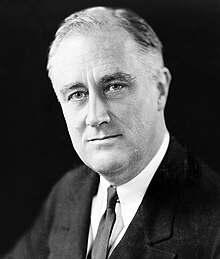New Deal
The New Deal was a series of programs launched by US President Franklin D. Roosevelt to solve the problems caused by the Great Depression. The New Deal is often split into two smaller New Deals: the First New Deal and the Second New Deal. During the First Hundred Days of Roosevelt's presidency, Roosevelt and his administration proposed many plans to fix the economy.

Under the New Deal a wide range of reforms were carried out, benefiting groups such as farmers and workers.[1][2][3]
Statistics
changePercentage of non-agricultural workers in labor unions, 1930: 11.6% Percentage of non-agricultural workers in labor unions, 1937: 22.6% prcentage of non-agricultural workers in labor unions, 1945: 35.5% Percentage of non-agricultural workers in labor unions, 1999: 13.9%
Abbreviations of individuals and agencies associated with the New Deal
changeCCC: Civilian Conservation Corps WPA: Works Progress Administration FDR: Franklin Delano Roosevelt AAA: Agricultural Adjustment Act TVA: Tennessee Valley Authority HOLC: Home Owners Loan Corporation FERA: Federal Emergency Relief Administration PWA: Public Works Administration CWA: Civil Works Administration NRA: National Recovery Administration
References
change- Kennedy, David; Cohen, Lizabeth; Bailey, Thomas (2006). "The Great Depresion and the New Deal, 1933–1939". The American Pageant (13th ed.). United States: Houghton Mifflin Company. ISBN 0-618-47940-6.